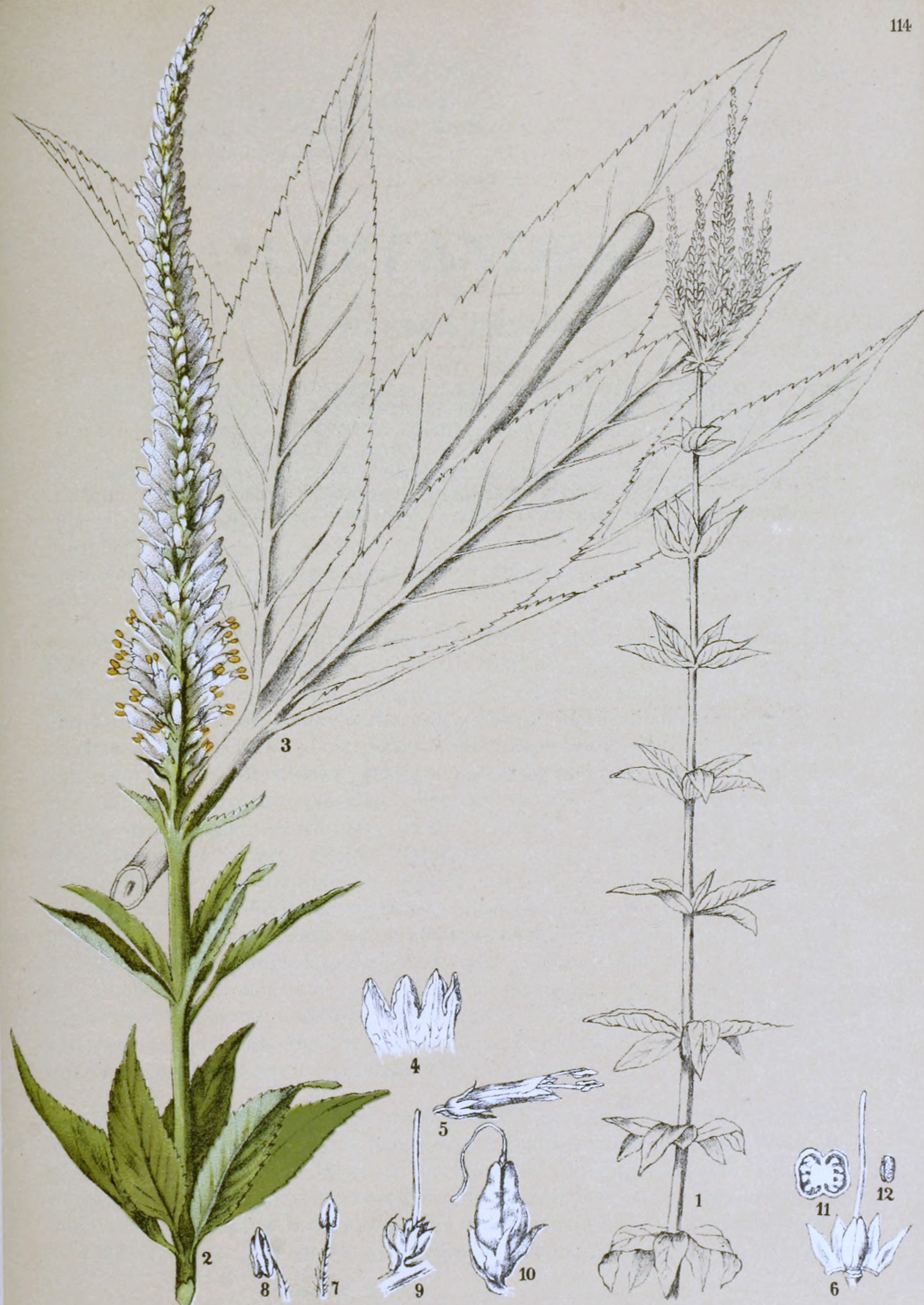
Leptandra virginica (L)
 Synonyms: Veronicastrum
virginicum (L.), Veronica virginica (Tourn.), Beaumont root, Bowman's
root, Bourman's root, physic root, Culver's physic, Culver's root, hini, oxadoddy, purple leptandra, whorlywort, tall
speedwell, tall veronica
Synonyms: Veronicastrum
virginicum (L.), Veronica virginica (Tourn.), Beaumont root, Bowman's
root, Bourman's root, physic root, Culver's physic, Culver's root, hini, oxadoddy, purple leptandra, whorlywort, tall
speedwell, tall veronica
Order: Scrophulariaceae
Description: Leptandra is a tall perennial native to eastern and central North America. It grows up to 1.5m tall and has a simple erect stem producing at intervals whorls of four to seven lanceolate, finely-toothed leaves on short stalks, and terminating in a long spike of white flowers. It is cultivated throughout the world.
Parts used: root and rhizome
Collection: the root should be unearthed in the autumn and stored for a year before use.
Constituents: Bitter principle (leptandrin), mannitol, dextrose, resin, fatty acids, volatile oil, saponins, phytosterols, glycoside (resembling senegin), tannins
Actions: Mild cathartic, cholagogue, emetic, diaphoretic, spasmolytic, gentle hepatic tonic with mild laxative properties.
Indications: Chronic constipation associated with hepatic dysfunction, cholecystitis, icterus.
Therapeutics and Pharmacology: Leptandra is a bitter root which, when dried, acts as a gentle laxative and liver tonic, stimulating the flow of bile. It has been used to treat the symptoms of hepatitis, for pain around the liver area, jaundice, and accompanying depression. It was formerly used to treat malaria and other fevers. The bitter principle leptandrin gently stimulates the liver and promotes the secretion of bile without irritating the bowels or purging.
Combinations: It may be combined with Taraxacum, Berberis and Capsicum as a cathartic and hepatic agent, or with Hydrastis and Acorus in constipation associated with flatulent distension.
Caution: Use only the dried root; the fresh root is violently cathartic and emetic and may cause bloody stools and even abortion. Never use in pregnancy.
Preparation and Dosage: (thrice daily)
Regulatory status GSL
Dried rhizome and root: 0.5-4g or by decoction
Liquid Extract: 1:1 in 70% alcohol, 0.5-4ml
Tincture: 1:5 in 70% alcohol, 2.5-10ml
Additional Comments: This root was introduced into European herbalism via the Seneca people who used it as an emetic to induce vomiting in both rituals and medicine.
Bibliography
BHMA 1983 British Herbal Pharmacopoeia, BHMA, Bournemouth.
Grieve, M. 1931 A Modern Herbal, (ed. C.F. Leyel 1985), London.
Hoffmann, D. 1990 The New Holistic Herbal, Second Edition, Element, Shaftesbury.
Lust, J. 1990 The Herb Book, Bantam, London.
Mabey, R. (ed.) 1991 The Complete New Herbal, Penguin, London.
Mills, S.Y. 1993 The A-Z of Modern Herbalism, Diamond Books, London.
Polunin, M. and Robbins, C. 1992 The Natural Pharmacy, Dorling Kindersley, London.
Wren, R.C. 1988 Potter's New Cyclopaedia of Botanical Drugs and Preparations, C.W.Daniel, Saffron Walden.










